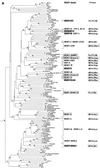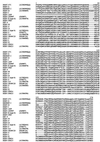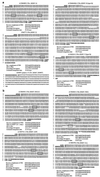Identification and characterization of novel human endogenous retrovirus families by phylogenetic screening of the human genome mapping project database
- PMID: 10729147
- PMCID: PMC111881
- DOI: 10.1128/jvi.74.8.3715-3730.2000
Identification and characterization of novel human endogenous retrovirus families by phylogenetic screening of the human genome mapping project database
Abstract
Human endogenous retroviruses (HERVs) were first identified almost 20 years ago, and since then numerous families have been described. It has, however, been difficult to obtain a good estimate of both the total number of independently derived families and their relationship to each other as well as to other members of the family Retroviridae. In this study, I used sequence data derived from over 150 novel HERVs, obtained from the Human Genome Mapping Project database, and a variety of recently identified nonhuman retroviruses to classify the HERVs into 22 independently acquired families. Of these, 17 families were loosely assigned to the class I HERVs, 3 to the class II HERVs and 2 to the class III HERVs. Many of these families have been identified previously, but six are described here for the first time and another four, for which only partial sequence information was previously available, were further characterized. Members of each of the 10 families are defective, and calculation of their integration dates suggested that most of them are likely to have been present within the human lineage since it diverged from the Old World monkeys more than 25 million years ago.
Figures






References
-
- Anderssen S, Sjottem E, Svineng G, Johansen T. Comparative analyses of LTRs of the ERV-H family of primate-specific retrovirus-like elements isolated from marmoset, African green monkey, and man. Virology. 1997;234:14–30. - PubMed
-
- Andersson M L, Lindeskog M, Medstrand P, Westley B, May F, Blomberg J. Diversity of human endogenous retrovirus class II-like sequences. J Gen Virol. 1999;80:255–260. - PubMed
-
- Bailey W J, Fitch D H A, Tagle D A, Czelusniak J, Slightom J L, Goodman M. Molecular evolution of the ψη-globin gene locus: gibbon phylogeny and the hominid slowdown. Mol Bol Evol. 1991;8:155–184. - PubMed
-
- Beck S, Sterk P. Genome scale DNA sequencing: where are we? Curr Opin Biotechnol. 1998;9:116–120. - PubMed
Publication types
MeSH terms
Associated data
- Actions
- Actions
- Actions
- Actions
- Actions
LinkOut - more resources
Full Text Sources
Other Literature Sources

